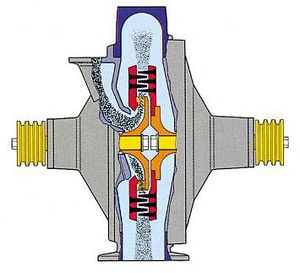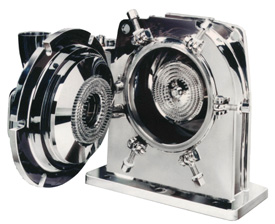Difference between revisions of "Impact Mills"
m |
|||
| Line 1: | Line 1: | ||
[[Category:Particle Size Reduction]]{{Knoppen}} | [[Category:Particle Size Reduction]]{{Knoppen}} | ||
[[File:Impact_Mill.jpg |thumb| right |Impact Mill]] | [[File:Impact_Mill.jpg |thumb| right |Impact Mill]] | ||
[[File:Impact_Mill_2.jpg |thumb| right |Impact Mill]] | |||
'''Impact Mills''' are screenless, high-speed beater mills for pulverising and micro-pulverising. The product to be processed is fed to the mill centrally via an inlet box at the top and is pre-crushed by primary beater tools when reaching the top of the rotor. The beaters also accelerate the product, moving it into the milling zone proper, at the side of the rotor. There the grinding stock fluidised in the air flow is comminuted by the grinding tools (rotor, stator). The stator is formed by a cover enclosing the rotor. The inside of this cover is provided with toothed grooves running vertical, i.e. crosswise to the sense of rotation of the rotor. The outside of the rotor is covered by numerous U-shaped sections which form a deep cassette-type structure. This geometry creates extreme air whirls in the rotor's grinding zone which induce intense secondary comminution processes due to the particles crashing into each other and due to friction and shearing forces. The final particle size can be adjusted over a wide range by changing the grinding rotor clearance, air flow and rotor speed. | '''Impact Mills''' are screenless, high-speed beater mills for pulverising and micro-pulverising. The product to be processed is fed to the mill centrally via an inlet box at the top and is pre-crushed by primary beater tools when reaching the top of the rotor. The beaters also accelerate the product, moving it into the milling zone proper, at the side of the rotor. There the grinding stock fluidised in the air flow is comminuted by the grinding tools (rotor, stator). The stator is formed by a cover enclosing the rotor. The inside of this cover is provided with toothed grooves running vertical, i.e. crosswise to the sense of rotation of the rotor. The outside of the rotor is covered by numerous U-shaped sections which form a deep cassette-type structure. This geometry creates extreme air whirls in the rotor's grinding zone which induce intense secondary comminution processes due to the particles crashing into each other and due to friction and shearing forces. The final particle size can be adjusted over a wide range by changing the grinding rotor clearance, air flow and rotor speed. | ||
Latest revision as of 01:44, 18 October 2013
Impact Mills are screenless, high-speed beater mills for pulverising and micro-pulverising. The product to be processed is fed to the mill centrally via an inlet box at the top and is pre-crushed by primary beater tools when reaching the top of the rotor. The beaters also accelerate the product, moving it into the milling zone proper, at the side of the rotor. There the grinding stock fluidised in the air flow is comminuted by the grinding tools (rotor, stator). The stator is formed by a cover enclosing the rotor. The inside of this cover is provided with toothed grooves running vertical, i.e. crosswise to the sense of rotation of the rotor. The outside of the rotor is covered by numerous U-shaped sections which form a deep cassette-type structure. This geometry creates extreme air whirls in the rotor's grinding zone which induce intense secondary comminution processes due to the particles crashing into each other and due to friction and shearing forces. The final particle size can be adjusted over a wide range by changing the grinding rotor clearance, air flow and rotor speed.
In addition to (micro) pulverisation in the < 100 µm range, the Impact Mill has proven to be very reliable and efficient in defibrating organic substances (paper, paperboard, cellulose, etc.), grinding-coating, cryogenic grinding, combined grinding/blending and grinding/drying.
Video

